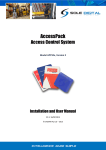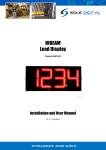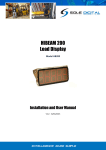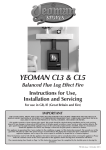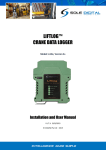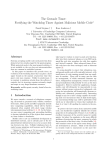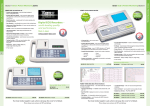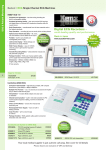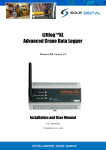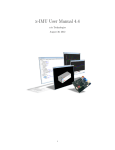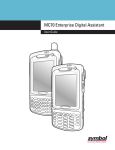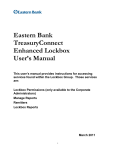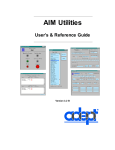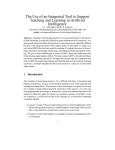Download AccessPoint Installation & User Manual
Transcript
AccessPoint Access Control System Installation and User Manual © Whiting Passport – 2015 © Whiting Passport – 2015 1 | Page CONTENTS 1 OVERVIEW............................................................................................................................ 4 2 SPECIFICATIONS .................................................................................................................... 5 2.1 Electrical Specifications ........................................................................................................... 5 2.1.1 AccessPoint Puck ...................................................................................................... 5 2.1.2 Interface Boards ....................................................................................................... 5 2.2 Communication Specifications................................................................................................ 7 2.3 Physical Specifications ............................................................................................................ 7 3 2.3.1 AccessPoint Puck ...................................................................................................... 7 2.3.2 Interface Boards ....................................................................................................... 8 INSTALLATION DETAILS ......................................................................................................... 9 3.1 Prior to Installation ................................................................................................................. 9 3.2 Wiring Connections & Diagrams ............................................................................................. 9 3.2.1 AccessPoint with Wiring Harness (APP100) ........................................................... 10 3.2.2 AccessPoint with Wiring Harness and E-Stop Button (APP101) ............................ 10 3.2.3 AccessPoint with Crane Pendant Board (APP102), 10 terminals ........................... 11 3.2.4 AccessPoint with Crane Pendant Board (APP102), 3 or 4 terminals...................... 13 3.2.5 AccessPoint Pre-installed on an 8 button Crane Pendant ..................................... 14 3.2.6 AccessPoint with Vehicle Board (APP103) - 1st/2nd/3rd generation designs ...... 15 3.2.7 AccessPoint with Door Board (APP105) ................................................................. 20 3.2.8 AccessPoint with Fixed Equipment Board (APP106) .............................................. 21 3.2.9 AccessPoint with Fixed Equipment Board, Case Type 1 (APP107) ......................... 23 3.2.10 AccessPoint with Fixed Equipment Board, Case Type 2 (APP116) ......................... 24 3.2.11 AccessPoint with PC Kit (APP108) .......................................................................... 26 3.2.12 AccessPoint with VFD Kit (APP109) ........................................................................ 26 3.3 Note for Installing AccessPoint on Critical Equipment ......................................................... 27 4 BASIC COMMISSIONING DETAILS......................................................................................... 28 4.1 Installing and Launching the FSU Application ....................................................................... 28 4.1.1 FSU Program Installation........................................................................................ 28 4.1.2 Installing the FSU Application ................................................................................ 28 4.1.3 Launching the application ...................................................................................... 28 © Whiting Passport – 2015 2 | Page 4.2 Connecting to the Device ...................................................................................................... 29 4.3 Managing Firmware .............................................................................................................. 29 4.4 Checking the Date and Time ................................................................................................. 32 4.5 Basic Setup ............................................................................................................................ 32 4.5.1 5 Applying Basic Settings........................................................................................... 34 ADVANCED COMMISSIONING DETAILS ................................................................................ 35 5.1.1 Motion Tab ............................................................................................................. 36 5.1.2 Card Tab ................................................................................................................. 37 5.1.3 Signals Tab .............................................................................................................. 37 5.1.4 Maintenance Tab ................................................................................................... 39 5.1.5 Advanced Tab ......................................................................................................... 40 6 DOWNLOADING DATA USING THE FSU ................................................................................ 43 7 ACCESSPOINT OPERATION .................................................................................................. 44 7.1 Logging On and Enabling Usage ............................................................................................ 44 7.2 User Initiated Logging Off ..................................................................................................... 45 7.3 Automatic Logging Off .......................................................................................................... 45 7.4 Resetting the Maintenance Interval ..................................................................................... 45 7.5 Electronic Tag Out ................................................................................................................. 45 7.6 Indicator States ..................................................................................................................... 46 8 TROUBLESHOOTING ............................................................................................................ 47 APPENDIX A: COMMUNICATION PROTOCOL ............................................................................... 48 APPENDIX B: FSU SYSTEM REQUIREMENTS ................................................................................. 51 APPENDIX C: FACTORY DEFAULT SETTINGS ................................................................................. 52 © Whiting Passport – 2015 3 | Page 1 OVERVIEW AccessPoint is an inexpensive, easy to use universal access control system that utilizes smart card technology to physically prevent machinery from being used by those who you have not authorized. AccessPoint can be fitted to any electrically powered device, including stand-alone, mobile or remote plant equipment. Users are automatically logged off when the equipment is stationary, idle or stopped. To ensure accountability, AccessPoint records who accessed the equipment and when they did so. An AccessPoint device consists of two parts: (a) a generic blue puck that contains the RFID reader and smart electronics, usually mounted on the outside of the equipment to be protected, and (b) a power supply board, specific to the type of equipment being protected, that is typically mounted inside the equipment. Currently AccessPoint kits are available for the following applications: Crane joystick radios and pendants Doors Vehicles Fixed equipment (e.g. Break-out machines, lathes, ovens etc) Computer terminals Variable frequency drives The type of AccessPoint kit must be specified at time of ordering. © Whiting Passport – 2015 4 | Page 2 SPECIFICATIONS 2.1 Electrical Specifications 2.1.1 AccessPoint Puck Parameter Vin Iin Start up Button Output Description Supply voltage Supply current Current Operating temperature Min 4 6 Typ 7 10 Max 12 90* 85# -40 Units VDC mA mA °C *only when communicating via Bluetooth # Extended operation at maximum temperature will reduce device life. 2.1.2 Interface Boards Note that models for crane radios, APP100 and APP101 do not have an interface board. 2.1.2.1 2.1.2.1.1 Crane Pendant Board (APP102) Pendant Board with 10 terminals Parameter Vin Relay Output 1 Relay Output 1 Relay Output 1 Relay Output 2 Relay Output 2 Relay Output 2 2.1.2.1.2 Description Supply voltage Current Voltage Power Current Voltage Power Min 18 Typ Max 55 500 60 10 500 60 10 Units VAC mA VAC W mA VAC W Min 18 Typ Max 250 4 250 >100 4 250 >100 Units VAC A VAC W A VAC W Pendant Board with 4 terminals Parameter Vin Relay Output 1 Relay Output 1 Relay Output 1 Relay Output 2 Relay Output 2 Relay Output 2 © Whiting Passport – 2015 Description Supply voltage Current Voltage Power Current Voltage Power 5 | Page 2.1.2.1.3 Pendant Board with 3 terminals Parameter Vin Relay Output 1 Relay Output 1 Relay Output 1 2.1.2.2 Min 18 Typ Max 250 4 250 >100 Units VAC A VAC W Vehicle Board (APP103) 2.1.2.2.1 APP103 (Plastic Case) Parameter Vin Relay Output (NO) Relay Output (NO) 2.1.2.2.2 Description Supply voltage Current Voltage Min 12 Typ Max 48 10 48 Units VDC A VDC Min 6 Typ Max 48 201 48 Units VDC A VDC APP103 (Metal Case) Parameter Vin Relay Output (NO) Relay Output (NO) 1 Description Supply voltage Current Voltage Power Description Supply voltage Current Voltage When relay common bridging link is used 2.1.2.3 Door Board (APP105) This board is used in AccessPoint LockBoxes (APP105LB, APP105BB). Parameter Vin Relay Output Relay Output 2.1.2.4 Min 8 Typ 12 Max 24 8 36 Units VDC A VDC Min 32 Typ Max 240 8 480 Units VAC A VAC Typ 5 Max 6 Units VDC Fixed Equipment Board (APP106, APP107, APP116) Parameter Vin Relay Output Relay Output (NO) 2.1.2.5 Description Supply voltage Current Voltage Description Supply voltage Current Voltage 24 PC Dongle (APP108) Parameter Vin © Whiting Passport – 2015 Description Supply voltage (USB) Min 4 6 | Page 2.2 Communication Specifications Communications between the device and a host is usually via a Bluetooth radio link. The Bluetooth device PIN is 0000. For more details on the communication protocol used to communicate with the AccessPoint, see Appendix A. 2.3 Physical Specifications 2.3.1 AccessPoint Puck The new AccessPoint Puck enclosure is made of glass filled nylon (Tested in accordance to UL94). Prior to May 2012, the enclosure was made from cast epoxy resin. Dimensions of the AccessPoint Puck are provided in the following table and diagram. Overall length (mm): 55 Overall width (mm): 50 Overall height (mm): 41 Weight (kg): Mounting: 160g Standard 22 mm hole Figure 1: Dimensions of AccessPoint puck © Whiting Passport – 2015 7 | Page 2.3.2 Interface Boards The overall dimensions of the interface boards and/or their cases are: Model Length (mm) Width (mm) Height (mm) Crane radio APP100, APP101 No board – wiring harness only Crane pendant board (3/4 terminals) APP102 54 40 25 Vehicle board (generation 1 in case) APP103 66 49 36 Vehicle board (generation 2 in case) APP103 107 68 32 Vehicle board (generation 3 in case) APP103 110 120 37 Door board APP104 51 19 11 Fixed equipment board (no case) APP106 89 60 43 Fixed equipment board, Case Type 1 with E-Stop APP107 120 85 103 PC board APP108 65 25 14 Fixed equipment board, Case Type 2 with cable harness APP116 105 74 40 Variable Frequency Drive board APP109 No board – wiring harness only LockBox (entire unit) APP105LB 200 300 200 BlanketBox (entire unit) APP105BB 500 400 210 © Whiting Passport – 2015 8 | Page 3 INSTALLATION DETAILS 3.1 Prior to Installation Before installing your AccessPoint device visually inspect the device and check that: (a) the type of AccessPoint mounting kit is appropriate for your application; (b) the case is not damaged and fits together securely; (c) wiring harness is not damaged. 3.2 Wiring Connections & Diagrams The AccessPoint puck comes with a multi-core output cable. The generic connections associated with each colored core are shown in Figure 2. START ENABLE OUT ENABLE IN HEARTBEAT GND 3.6-10V DC Orange Blue Yellow Green Black Red Figure 2: AccessPoint Puck Outputs Start: The Start Output provides 1-5 pulses at logon. The Start connection is an open collector and rated to 24V 10mA. Enable OUT: Enables and disables the operation of the equipment. It changes state when a valid card is presented. Enable IN: Monitors the status of the E-Stop/Enable/Seat-Switch etc. Any voltage between 2VDC and 100VDC inclusive will activate this input and cause the AccessPoint to log off instantly. Heartbeat: If the equipment the AccessPoint is to be installed on has a light or LED that indicates the equipment is functioning (for example, a flashing green LED), the AccessPoint heartbeat connection is connected to the terminal that changes level. A range of Application notes have been developed that provide detailed information on how to wire these connections on a variety of specific equipment types/models. These are available for download from www.WhitingPassport.com. Generic guidelines for each model type are provided in the following sections. © Whiting Passport – 2015 9 | Page 3.2.1 AccessPoint with Wiring Harness (APP100) This model of AccessPoint is used for HBC Micron or ECO radios. AccessPoints need to be factory installed on these devices due to their size and circuit board complexity. Consequently, no wiring diagram is provided. 3.2.2 AccessPoint with Wiring Harness and E-Stop Button (APP101) This type of AccessPoint is typically installed on HBC joystick radios. 3.2.2.1 Wiring Harness Connections Wire color Description Black Red Green Orange Yellow Blue Battery –ve Battery +ve (>3.6V) Heartbeat / Flashing LED Start button E-Stop, prewired Not connected These can be connected as per the wiring diagram shown in Figure 3. © Whiting Passport – 2015 10 | Page Existing E-Stop Wiring Replace Existing E-Stop White Radio Battery Black Red Find the pin that pulses when the LED flashes green Green Yellow Black Orange X Break cable Blue (Not Connected) Start Button Figure 3: Wiring diagram for APP101 3.2.3 AccessPoint with Crane Pendant Board (APP102), 10 terminals 3.2.3.1 Pendant Board Connections - 10 inputs 10 9 8 7 6 5 4 3 2 1 This diagram shows the location of terminal 1. © Whiting Passport – 2015 11 | Page Terminal Number 1 2 3 4 5 6 7 8 9 10 3.2.3.2 Name Description E-Stop Monitor Switch Terminal E-Stop Monitor Switch Terminal 48VAC Input 48VAC Input E-Stop Output E-Stop Output Start Output Terminal Start Output Terminal Horn Output Terminal Horn Output Terminal Connects to second NC contact on E-Stop Button Power Connects in series with E-Stop switch to deactivate crane Replaces start switch so AccessPoint can pulse a start signal to activate crane Connect in parallel to the start button to sound horn when crane starts Pendant Wiring Diagram - 10 inputs Figure 4: Connecting an APP102 (Horn outputs not shown) It WILL be necessary to run a new 48VAC neutral conductor from the switch panel to the pendant to provide the AccessPoint Interface board with 48VAC. © Whiting Passport – 2015 12 | Page 3.2.4 AccessPoint with Crane Pendant Board (APP102), 3 or 4 terminal 3.2.4.1 3 -4 terminal Pendant Board Connections Terminal numbers are marked on the circuit board from 0 to 3. Terminal Description Number 0 Connects to 0 Volts 1 Power (Crane control voltage) 2 Main contactor hold circuit / control voltage common 3* Main contactor start circuit (not used in normal installs) Note: Terminal 3 is not included on the 3-input pendant board. 3.2.4.2 3 -4 Terminal Pendant Wiring Diagram 1 EXISTING WIRING 2 3 If wired on existing pendant. Otherwise leave out (e.g. Demag pendants). ESTOP ACCESSPACK INSTALL Technician will need to run this voltage down a spare core. 0V START 1 2 3 1 2 3 ESTOP 0 4 INPUT PENDANT BOARD Not included on a 3 input pendant board Figure 5: Connecting a new 3 or 4 input pendant board (APP102) © Whiting Passport – 2015 13 | Page 3.2.5 AccessPoint Pre-installed on an 8 button Crane Pendant To simplify onsite installation, an AccessPoint can be factory fitted to a new 8 push button pendant. This is installed as per Figure below. Onsite work then involves wiring up the pendant to the crane. Figure 6: AccessPoint pendant board installed on a new 8 button crane pendant © Whiting Passport – 2015 14 | Page 3.2.6 AccessPoint with Vehicle Board (APP103) In 2013, the Vehicle board was revised and enclosed in a new case. This section contains information about using both board designs. The primary difference between the two designs is that the first generation vehicle kit only enabled the engine, whilst the second generation is actually capable of cranking the engine. 3.2.6.1 APP103 Board Connections The APP103 Vehicle Board comes in an ABS box (rather than aluminium) and includes mounting tabs on each side. The APP103 vehicle kit can either enable the accessories or crank the engine, depending on how it is connected. Cable Number Label Description 1 2 3 4 5 6 GND 12-48V ACC CRANK ENABLE HEARTBEAT Ground connection Power connection 12-48VDC Relay Output to Start Accessories Relay Output to Start Crank Input to initiate looking for an access card Periodic input to check that access should be maintained © Whiting Passport – 2015 15 | Page APP 103 Wiring Connections (ABS) TO ACCESSPACK 3.2.6.2 APP103: Vehicle Kit (2nd Design) OFF ACC Out 2 ACC IGNITION SWITCH NB: Key is removed but can be used as Emergency backup. CRANK Out 1 CRANK 12-48VDC New E-STOP 12-48 VDC GND 0V GND Figure 7: Connecting an APP103 Kit (ABS) © Whiting Passport – 2015 16 | Page 3.2.6.3 APP103 Board Connections The next generation of the APP103 Vehicle Board comes in a physically larger metal box with a large ruggedized cable assembly and bigger relays than previous versions. It can be configured with voltage free contacts, or as a common supply, dual output system. APP103 is suitable for interfacing with both electric and internal combustion engine vehicles. Cable Color Label Description Green /Yellow Brown Orange White Red Blue GND Ground connection ACC COM ACC CRANK COM CRANK ENABLE Relay 1 (N/O) (Acc circuit) Relay 1 Common Relay 2 (N/O) (Crank circuit) Relay 2 Common Pull high to disable © Whiting Passport – 2015 17 | Page APP103 Wiring Connections for Electric Vehicles (Metal) TO ACCESSPACK 3.2.6.4 12-48V APP103: Vehicle Kit (3rd Generation) Seat Switch Optional E-Stop . Blue Brown Existing Stop or Main Contactor Coil circuit Orange Red 12-48 VDC Green & Yellow 0V GND Figure 8: Example wiring for an electric vehicle © Whiting Passport – 2015 18 | Page APP103 Wiring Connections for Vehicles with IC Engines(Metal) TO ACCESSPACK 3.2.6.5 12-48V APP103: Vehicle Kit (3rd Generation) Seat Switch Optional . Blue OFF ACC Brown IGNITION SWITCH NB: Key is removed but can be used as Emergency backup. CRANK White Orange 12-48 VDC Red New E-STOP Link required if circuit draws more than 10A Green & Yellow 0V GND All wiring in parallel with existing connections. Figure 9: Example wiring for a vehicle with an IC Engine © Whiting Passport – 2015 19 | Page 3.2.7 AccessPoint with Door Board (APP105) 3.2.7.1 Door Board Connections Cable Number 3.2.7.2 Label Details 1 2 GND 12VDC 3 4 Strike + Strike - 0V 9-18VDC with enough current to operate the door strike Output to door strike unit Typical APP105 Wiring Typical wiring for connecting an AccessPoint to an electronic door strike is provided in Figure 10. Figure 10: Example of how to connect an APP105 © Whiting Passport – 2015 20 | Page 3.2.8 AccessPoint with Fixed Equipment Board (APP106) 3.2.8.1 Fixed Equipment Board Connections This model of AccessPoint is usually used for controlling access to 3-phase contactor started machines or single phase switched circuit equipment. Label Details START N (Neutral) A (Active) STOP 8A 440VAC, Replaces start or power switch 24-240VAC Neutral 24-240VAC Active To second switch block on E-Stop switch © Whiting Passport – 2015 21 | Page 3.2.8.2 Example APP106 Wiring Diagram For a typical 3-phase motor wired as shown in Figure 11, then an example of how you can connect the APP106 model AccessPoint is provided in Contacts operated by contactor coil L1 A L2 A L3 A B Overload Protection 3 phase motor Overload Contacts Contactor Coil START STOP Toggle FIXED EQUIPMENT BOARD A N Pulse N Figure 12. Contacts operated by contactor coil L1 A L2 A L3 STOP Overload Protection 3 phase motor A START Overload Contacts B Contactor Coil Figure 11: Typical 3 phase motor setup © Whiting Passport – 2015 22 | Page Contacts operated by contactor coil L1 A L2 A L3 A B Overload Protection 3 phase motor Overload Contacts Contactor Coil START STOP Toggle FIXED EQUIPMENT BOARD A N Pulse N Figure 12: Example of how to connect an APP106 to a typical 3-phase machine as per Figure 11. 3.2.9 AccessPoint with Fixed Equipment Board, Case Type 1 (APP107) 3.2.9.1 Fixed Equipment Board Connections This model of AccessPoint is typically used to control access to single phase machines without an existing push-button E-Stop. © Whiting Passport – 2015 Label Details START N (Neutral) A (Active) STOP 8A 440VAC, Replaces start or power switch 24-240VAC Neutral 24-240VAC Active To second switch block on E-Stop switch 23 | Page 3.2.9.2 Example APP107 Wiring An example of how a model APP107 AccessPoint can be installed on a single phase electric machine is provided in Figure 13. Note that the E-Stop is already prewired to the button on the fixed equipment case. Figure 13: Example of how to wire an APP107. 3.2.10 AccessPoint with Fixed Equipment Board, Case Type 2 (APP116) 3.2.10.1 Fixed Equipment (BOM) Board Connections This model of AccessPoint is usually used for controlling access to 3-phase contactor started machines or single phase switched circuit equipment with a separate start and E-Stop button. It is a variant of APP106 with an additional prewired emergency stop and enclosed in a case. This is the model typically supplied for Break Out Machines. © Whiting Passport – 2015 24 | Page Label Details START N (Neutral) A (Active) STOP 8A 440VAC, Replaces start or power switch 24-240VAC Neutral 24-240VAC Active To new E-Stop switch (prewired) 3.2.10.2 Example APP116 Wiring for BOM An example of how a model APP116 AccessPoint can be installed in a break out machine (or other 3phase machine with separate start and stop switches) is provided in Figure 14. Note that the replacement E-Stop is already prewired to the cable emanating from the case. Contacts operated by contactor coil L1 A L2 L3 A Overload Contacts NEW E-STOP B To AccessPack puck 3 phase motor A Contactor Coil Prewired N Supplied wiring harness Overload Protection Not connected N A Toggle Pulse START STOP FIXED EQUIPMENT BOARD INSIDE CASE Prewired internally Figure 14: Example of how to wire an APP116. © Whiting Passport – 2015 25 | Page 3.2.11 AccessPoint with PC Kit (APP108) 3.2.11.1 PC Kit Connections The PC Kit fits into a USB slot onto the machine. The other end is connected to the AccessPoint, which is mounted where desired. There is no further wiring. To configure the computer to operate using an AccessPoint, download and run the AccessPointPC utility, which is available from the AccessPoint webpage: www.whitingpassport.com/ products/access-point.html 3.2.12 AccessPoint with VFD Kit (APP109) This AccessPoint kit is physically identical to an APP100 kit (AccessPoint with wiring harness) used for some types of crane radios. The only difference is that the AccessPoint itself may be preconfigured with slightly different timeout settings. However, these can always be altered using the FSU program as described in the following sections of this manual. 3.2.12.1 VFD Kit Connections Wire color Details Red Black Yellow Orange/Coral Blue Green 4-12V DC Ground E-Stop (Active high) Start (NPN) Not connected Not connected For examples on how to install an AccessPoint on different types of variable frequency/speed drive, see the application note: http://www.whitingpassport.com/assets/files/accesspoint/AccessPoint_VFD_control.pdf © Whiting Passport – 2015 26 | Page 3.3 Note for Installing AccessPoint on Critical Equipment Although failure rates on electronic devices such as AccessPoint are incredibly low when subjected to normal operating conditions, they are not zero. Severe temperature fluctuations and/or mechanical mishandling further increases the risk of failure. If downtime incurred by an AccessPoint failure is absolutely unacceptable, we recommend fitting a key switch (or similar device) in parallel with the AccessPoint to allow the protected equipment to be used if/when a problem occurs. The end user should conduct a risk assessment to decide whether this is appropriate for their site. © Whiting Passport – 2015 27 | Page 4 BASIC COMMISSIONING DETAILS The AccessPoint is designed to be commissioned using a laptop computer. You will need a LINK-2 Bluetooth Modem and the Field Service Utility (FSU) software application loaded on a laptop. 4.1 Installing and Launching the FSU Application 4.1.1 FSU Program Installation Ensure that your computer is switched on, connected to the internet and that the minimum required software versions are installed (see Appendix B for minimum system requirements). Ensure that the LINK-2 modem is installed and that the drivers have loaded. 4.1.2 Installing the FSU Application The latest FSU software can be downloaded from: http://www.whitingpassport.com/products/access-point.html You should check this location periodically for updates. 4.1.3 Launching the Application Double click on the Passport FSU program icon. You’ll find it in the programs folder of your start menu. © Whiting Passport – 2015 28 | Page 4.2 Connecting to the Device The FSU will scan for Bluetooth enabled devices. This process takes approximately 10 seconds, when complete a list of all Passport devices within range will be displayed. If a particular AccessPoint unit is not found, ensure it is powered up and press the repeat the search. icon to NB: The Bluetooth link between the Laptop using a Link-2 and an AccessPoint has a range of approximately 100m. Select the AccessPoint you wish to configure by double clicking on the relevant icon. 4.3 Managing Firmware If you running an older version of the FSU application on your laptop then you should update this before continuing. The process for updating the firmware on your Passport device has changed. Firmware should only be updated if you: a) specifically want a new feature that is only available in later versions; b) are experiencing a problem that has been rectified by a later version; c) are experiencing a problem and need to roll back to an earlier firmware version that didn't cause the problem you are experiencing; or © Whiting Passport – 2015 29 | Page d) have been specifically instructed to do so by your AccessPoint supplier. To check for new firmware versions or to access old firmware versions, return to the Device Display screen and right click the desired equipment icon. Select 'Manage Firmware'. A new window will popup and show the FSU software connecting to the device. When this is complete, the window will show the name of the device, its current firmware version and a list of newer firmware that is available for the device. If you need to roll back to an earlier version, check the 'Show old versions' box in the lower left corner of the window. Select a firmware version and then press the <Apply firmware> button that appears in the lower right corner of the window: © Whiting Passport – 2015 30 | Page The display will change to the following: As the message states, DO NOT switch off the AccessPoint or the computer running the FSU software, or remove the Link2 modem until you are told to do so. If either device loses power then the AccessPoint may become unusable and the device will need to be returned to your supplier for repair. When the firmware has finished updating successfully you will see a popup window and also be told to power cycle the device before reconnecting: message in the Close this window, wait for the manage firmware window to close (this may take 20 seconds) and power cycle the device as instructed. You will be returned to the first FSU screen, Manage Connections. Wait a few seconds after power cycling the device and then select the device you wish to connect to by double clicking the device. © Whiting Passport – 2015 31 | Page 4.4 Checking the Date and Time After selecting the device, the FSU application will automatically verify whether the AccessPoint has the same date/time as the computer running the FSU application. If the times are not the same, the following pop up window will display on the screen: Press <Yes> to update the devices date/time or press <No> to leave the date/time on the device as it is. NB: If you did not see this window, then your device has the same date/time as your computer. 4.5 Basic Setup Once firmware versions and date/time has been verified, the following screen will appear. © Whiting Passport – 2015 32 | Page If the AccessPoint is in Basic mode (where any card will activate the device), this setup window will immediately be followed by a warning message: Leave the device in Basic mode if you wish to enable any RFID card to grant access to the controlled device. In this mode only the card serial number is recorded. This is useful when you are first commissioning the device and have not yet programmed cards. Select Enterprise mode to enable the use of the AccessPoint Manager to configure permissions to individual devices. You can change the mode at any time through the Card tab (see Advanced Commissioning Details). The ‘Setup’ tab allows you to configure: - The name of the equipment; The location (site) of the equipment; The class of the equipment; NB: This information MUST EXACTLY MATCH the entries for the equipment in the database and is usually provided to you by your equipment vendor. Any changes to these fields will be automatically saved once you exit the field. © Whiting Passport – 2015 33 | Page 4.5.1 Applying Basic Settings The easiest way to configure an AccessPoint is to load a set of basic presets associated with its Equipment Type. To do this, select the appropriate equipment from the 'Set Equipment Type' field: A popup box will appear asking you to confirm that you wish to configure the AccessPoint as this type of equipment. Pressing <Yes> will overwrite the existing settings on the AccessPoint and close the Popup box. A message box will confirm that the settings have been saved. Alternatively, pressing <No> will close the box without making any changes. The equipment type that was applied will be shown in the Set Equipment Type field. Note: If this field is blank then this AccessPoint's settings do not match any current preset file. This may be because the settings were tuned using the Advanced Configuration options or that the standard preset file has changed since the preset was first applied. Changing the settings using the 'Set Equipment Type' presets will not make any changes to the maintenance parameters or binding to a logger. By default these are not enabled. © Whiting Passport – 2015 34 | Page 5 ADVANCED COMMISSIONING DETAILS By default, AccessPoint Behavior settings are hidden from view. To tune individual configuration settings, or activate/change other features such as maintenance intervals, press <CTRL-A>. A number of other tabs will appear: Access the advanced commissioning tabs if you want to: a) set maintenance intervals and lockout behavior; b) tune motion thresholds if the AccessPoint is not behaving as required after applying one of the basic presets; c) change how the AccessPoint reads the user's RFID cards (e.g. when using some building access cards); d) change the mode of AccessPoint operation from Enterprise to Basic mode; e) save a new preset; f) bind to a datalogger; g) add/remove Tag Out without using a Magic Card; OR h) set mandatory token types. If you are not doing any of these things, then the basic configuration options available through the Setup tab should be sufficient to commission this device. © Whiting Passport – 2015 35 | Page 5.1.1 Motion Tab This tab displays sliders that adjust parameters relating to the AccessPoint’s motion detection hardware. Simply touch the slider to change the value. A text box at the bottom of the page contains an explanation of each parameter and its current value. 5.1.1.1 Motion Parameters Motion Settle Time is the amount of time the AccessPoint will wait after logging on or off before beginning to look for motion. It is typically set to a low value. Motion Threshold is the basic sensitivity of the motion system. Smaller numbers are more sensitive; 10-20 are typical values. In use, the AccessPoint also dynamically adjusts the basic motion sensitivity to eliminate the chance of inadvertent logouts. Motion Timeout sets the time between the AccessPoint motion system detecting stillness and the beginning of the Put Down timeout. Set this to a larger value if the unit will be periodically put down for a few seconds. Put Down Timeout sets the time the red LED will flash (after the motion timeout has expired) before the AccessPoint will log the user out. In Door Mode this parameter sets how long the door is held unlocked after an authorized card swipe. 5.1.1.2 Setting up motion detection To manually tune motion detection, first set the Motion Timeout to 1 or 2 and the Put Down Timeout to about 200. The swipe a valid card to activate the AccessPoint. This will cause the AccessPoint to flash the red LED whenever it thinks it is motionless. In addition to the red LED being off, the motion icon will appear at the bottom of the screen when AccessPoint senses motion. © Whiting Passport – 2015 36 | Page You can now adjust the Motion Threshold (i.e. the sensitivity of the system) to a level appropriate for the installation. When you are happy with the sensitivity, adjust the Motion Timeout and Put Down Timeout as required. 5.1.2 Card Tab This tab displays sliders that that adjust parameters relating to the AccessPoint’s card reader. Simply touch the slider to change the value. A text box at the bottom of the page contains an explanation of each parameter and its current value. 5.1.2.1 Card Parameters RFID Scan Timeout sets the length of time the AccessPoint will look for a valid card before returning to an idle state. Setting this value to zero will disable the return to idle and the AccessPoint will scan continuously for a card. AccessPoint Mode: Select Basic mode to enable any RFID card to grant access to the controlled device. In this mode only the card serial number is recorded. Select Enterprise mode to enable the use of the AccessPoint Manager to configure permissions to individual devices. Log Unauthorized Cards: Checking this box will cause the AccessPoint to record the names or serial numbers for both accepted and rejected card swipes. Mifare Settings: These settings configure the AccessPoint to use only part of the space on the swipe card. This is usually done to allow a customer’s existing access card to be used with the AccessPoint system. They should be set to 0 and 160 (as shown) unless directed by the AccessPoint Support desk. 5.1.3 Signals Tab This tab displays parameters relating to the AccessPoint’s inputs and outputs. A text box at the bottom of the page contains an explanation of the parameter and its current value. © Whiting Passport – 2015 37 | Page The current status of the AccessPoint is also shown. 5.1.3.1 Signals Parameters Heartbeat Timeout: This slider sets the time after detecting a heartbeat signal (a flashing LED, a closed set of contacts etc) that the AccessPoint will consider the equipment to have stopped or timed out. After the Heartbeat Timeout has expired, the user is logged out. Simply drag the slider to change the value. Emergency Stop Behavior: These fields configure how the AccessPoint behaves when the Emergency stop signal is detected. Invert Input inverts the polarity of the EStop/Enable input signal. Invert Output inverts the polarity of the EStop/Enable output signal. Sensitivity is the amount of time that the E-Stop input has to be active before this signal is registered. Decrease this if you suspect noise on the E-Stop is causing the AccessPoint to log off by dragging the slider to the left. Edge Triggered configures the AccessPoint to log out the user only when the E Stop signal transitions from not stopped to stopped. After logging out and disabling the equipment, the AccessPoint will immediately start looking for a card. Check this box when the equipment is stationary and has a separate start/stop circuit which will be activated after the user has swiped their card (e.g. Fixed equipment with the AccessPoint mounted on the wall). It is recommended that the 'Sensitivity' slider be set to 0 (i.e. Scan indefinitely) and motion sensing disabled when this checkbox is set. © Whiting Passport – 2015 38 | Page Output Modes: These configure how the outputs behave when a card is presented. In the default mode (no boxes selected) the enable/E-stop is asserted and the start button pulses a number of times as defined by "Start Pushes". Start pushes: Sets the number of times the start output will be pulsed when the AccessPoint is activated. When set to > 1, then the sequence is as follows: 600mS pulse. 500mS Pause. 2500mS pulse. 500mS Pause/600mS pulses repeated Alternative output modes are: Pendant Mode: When unchecked, output 1 will toggle high or low to indicate the current locked/unlocked status of the AccessPoint. When checked, output 1 will pulse high for one second when a user logs on. This output is used to push a start button. Door Mode: When Door Mode is checked, the Estop output (output 1) will pulse for the duration set by “Put Down Time Out” (This appears in place of "Start Pushes" when Door Mode is first checked). It will also not be possible to bind an AccessPoint to a logger (see General Tab) in Door Mode. Crank Mode: When Crank Mode is checked, the Start button is be enabled for as long as a card is held in front of the AccessPoint. This is typically used to crank an engine instead of turning a key. 5.1.4 Maintenance Tab The Maintenance tab allows you to view the total operating hours of the equipment. This tab also allows you to set a mandatory Maintenance interval (if desired). When the selected date is reached and the maintenance interval is >0, the AccessPoint will either continuously flash both LED’s at the same time to alert the user that the equipment’s maintenance period has expired or lock out the equipment (by declining any access requests after the due date). The AccessPoint will remain in the alert/locked state enabled until the maintenance due date is reset. This can be done by changing the date using the FSU © Whiting Passport – 2015 39 | Page application or by swiping a specially issued recertification card. If using the latter, the <Next Due> date will be set to the current date (date that the recertification card is presented) plus the <maintenance interval>. 5.1.4.1 Run Hours Parameters Add to Bluetooth Name causes the total operating hours to be appended to the Bluetooth name of the device. This allows the run hours to be read with any mobile phone or laptop. Under normal conditions, the run hours will be updated twice a day. Maintenance interval: This slider changes the required periodicity of re-certification or maintenance. If set to zero, alarming or lockout due to overdue certification will NOT be enabled. Next due is the date by which mandatory certification or maintenance must be performed. If blank, alarming or lockout due to overdue certification will NOT be enabled. Lock when due establishes whether, in the event of an overdue certification period, the AccessPoint will merely flash to alarm the operators or whether it will actually disable the equipment Note: This option should only be selected following a risk assessment that confirms that there is no possibility for unsafe conditions arising as a result of the equipment being locked out. Tagged Out is checked when the protected machine is not to be used by anyone (e.g. out for maintenance). The AccessPoint will flash both LEDs simultaneously to alert operators of this state. This check box can be checked/unchecked by swiping a Tag Out Magic Card. 5.1.5 Advanced Tab 5.1.5.1 Save Settings as a Preset If you have changed the configuration settings from their default values and want to save these as a new type of preset, press the <Save Settings as Preset> button. A new dialog box will appear: Enter the name for this configuration and a brief description. Press <Save>. © Whiting Passport – 2015 40 | Page A new preset file (*.ap) with the name you have supplied will be saved in the \Documents\FSUPresets\ folder on the laptop being used to configure the AccessPoint. It is saved to your specific directory, so will only be visible to your login. If you want other people to use this preset file, copy the *.ap file to copied to their Documents\FSUPresets\ folder. You may have to manually create this folder. To delete the preset, delete the file from that Folder. 5.1.5.2 Bind to a Logger Binding an AccessPoint to a Liftlog™ or Liftlog™XL data logger, tells the AccessPoint to send card swipe information to that logger so that it can record the operator’s name along with the usage history of the crane. First check that the logger is connected, powered up and configured (commissioned). Refer to the Liftlog™ or LiftlogXL user manuals for how to do this. To begin the binding process, press <Bind to a Logger>. The following screen will appear: Select the desired logger to bind to and press <OK>. If the desired logger is not in the list, check that the logger is power up. Press <Cancel> and repeat the binding process. NB: If the AccessPoint is in Door Mode, you will not be able to bind the AccessPoint to a logger as the <Bind to a Logger> button will be disabled. To check whether the AccessPoint is in Door Mode, click on the <Signals> tab (see Section 4.5). © Whiting Passport – 2015 41 | Page 5.1.5.3 Defining Required Tokens In its default state, the AccessPoint authorizes use if a card is presented containing any token that matches either the Equipment, Site or Class listed on the Setup tab. In situations where multiple sets of permissions are required to operate equipment (e.g. A forklift license and a site induction), check the type of tokens that must be present on the card. © Whiting Passport – 2015 42 | Page 6 DOWNLOADING DATA USING THE FSU The AccessPoint can currently store approximately 200 events in its onboard memory. Data can be downloaded from the AccessPoint using the FSU application. (This may be required if you do not have a Site Sentinel that automatically uploads the logon history to a secure webpage. ) Refer to section 4.1 for downloading an installing the FSU application. Connect to the desired AccessPoint as detailed in 4.2. Select the Usage tab: A list of users who have recently activated the AccessPoint will be displayed. Only the most recent 10 records are shown initially. Depending on the model of AccessPoint, it may also show the date and time of each access and whether the user’s card was accepted or rejected. The <refresh> button updates the logon list in the event that another operator has logged on while connected to the AccessPoint. The <save to file> button commences a dialogue to save the list to a text file on the computer. When the list is long, only first 10 entries are shown and the load all button is activated. Press <load all> to load the remaining entries: A blue progress bar is visible on the bottom of the screen as data is being loaded to indicate how much data has yet to be retrieved. This may take some time depending on the amount of data stored on the device. © Whiting Passport – 2015 43 | Page 7 ACCESSPOINT OPERATION The AccessPoint is used by placing specially configured AccessPoint cards1 over the card swipe target (“swiping”). Swiping range is limited to approximately 20mm. 7.1 Logging On and Enabling Usage To log on to a piece of equipment fitted with an AccessPoint: 1) Press the E-Stop button and keep it depressed. 2) Ensure the equipment is powered up. a. As the AccessPoint power is first reconnected both lights will flash briefly and then the green light will flash for several seconds while it searches for a Liftlog logger. b. If the green light flashes followed by the red light flashing slowly, the AccessPoint could not find a logger. The AccessPoint will continue to flash the green light followed by slowly flashing the red light at regular intervals (about 30 seconds). c. When the green light stops flashing with no slow red flashing, initial communication is complete. 3) Release the E-Stop button. AccessPoint will flash the red and green lights alternately indicating that it is ready to read a user card. 4) Swipe a user card by moving card across the face of the AccessPoint (see Figure 15). AccessPoint will turn the green light on for an authorized card read or turn on the red light for an unauthorized card read. Figure 15: Location to swipe an AccessPoint 1 For information on configuring cards using the AccessPoint Manager software see the AccessPoint Manager User Guide, available from http://www.whitingpassport.com/products/access-point.html © Whiting Passport – 2015 44 | Page With an authorized card read, the equipment will be enabled by the AccessPoint. The equipment will beep (if a beeper is fitted) and the AccessPoint green light will flash slowly to indicate that the equipment is operable. 7.2 User Initiated Logging Off To log off and make the equipment safe: Press the emergency stop button (if fitted) or other usual shutdown device (e.g. Power, ignition, or isolation switch). The current user will be logged off and the equipment made inoperable. After being logged out, the AccessPoint must once again be swiped before the equipment can be used. 7.3 Automatic Logging Off The user will also be logged out if one of the following occurs: the equipment has an inactivity timeout. is stationary for a preconfigured period (if motion sensing is enabled), The Stop input is connected to a seat switch, pressure pad or some other sensor. When the AccessPoint detects no motion for a configured interval, the red light will flash rapidly for configurable period to warn the user of the impending logout. During this period, moving the AccessPoint will reset the timeout period and the operator will remain logged on. After being logged out, the AccessPoint must once again be swiped by a valid card before the equipment can be used. 7.4 Resetting the Maintenance Interval If a mandatory inspection interval has expired and the ‘Lock when due’ parameter has been selected (see section 5.1.4 for more information on setting this parameter), then the operator will not be able to activate the AccessPoint and enable operation until the inspection/maintenance/calibration has been performed and the maintenance interval reset using either the FSU application, or the 'Maintenance' magic card. Swiping a 'Maintenance' magic card will reset the <Next Due> date (as shown on the Maintenance tab of the FSU application) to the PC's current date plus the < maintenance interval>. 7.5 Electronic Tag Out Swiping the 'Tag Out' card will prevent all users from enabling the AccessPoint and hence stop everyone from using the protected machine. To re-enable access to authorized users re-swipe the © Whiting Passport – 2015 45 | Page same 'Tag Out' card. Alternatively, this feature can be disabled by connecting to the device using the FSU application and disabling the <Tag Out> check box on the Maintenance Tab. 7.6 Indicator States The current state of the AccessPoint is indicated by two lights flashing in different ways, as described in the following table. State LED signals Green Flash Rate Notes Red Power up Quick single flash red and green together Looking for Liftlog after power on Medium rate Cannot find Liftlog Slow Check Liftlog for powered up state Idle – logged off Ready to swipe card Alternating flashing Logged on Slow Card Accepted Light on 2 seconds Card Rejected See your AccessPoint administrator About to be logged off and logged off (before idle state) Fast Maintenance period expired OR Quick flash red and green together AccessPoint tagged out Will flash continuously until maintenance is performed/ tag removed Red light on Green light on Red light flashing Green light flashing Red light off Green light off © Whiting Passport – 2015 46 | Page 8 TROUBLESHOOTING Fault Cause Fix No lights when power is applied No power to AccessPoint Check power output from application board. This should be 5V between RED and BLACK. Lights flash when E-Stop is pushed in and don’t flash when the E-Stop is pulled out E-Stop setting is inverted Change the ‘Invert E-Stop’ setting. Unit rejects all cards Incorrect configuration Check the spelling and capitalisation of the Equipment, Site, and Class settings of the AccessPoint. They must match the values on the web site exactly. Battery not charged on a radio remote Charge the battery. AccessPoint requires at least 3.3V to operate correctly. AccessPoint has been swiped with a Tag Out card. Rectify the equipment fault that initiated the Tag Out. When safe to do so, reswipe the Tag Out card to return the AccessPoint to its normal operating mode. Maintenance interval has been exceeded and lockout selected (both LEDs will be flashing). Undertake the required maintenance and then either (a) swipe a Maintenance Card to reset the maintenance period or (b) connect to the AccessPoint using the FSU and enter the Next Due date. Unit accepts all cards Unit is in Basic mode Select ‘Enterprise Mode’ on the card tab of the FSU. AccessPoint starts equipment and then logs off after a few seconds. Heartbeat timeout is enabled. If it is not being used, set the heartbeat timeout in the FSU to zero (i.e. disabled). Motion timeout settings are incorrect. Try disabling motion logoff by setting putdown timeout to zero. Red LED flashes continuously Insufficient voltage to drive AccessPoint. Check battery or power supply from application board (5VDC between black and red) © Whiting Passport – 2015 47 | Page APPENDIX A: COMMUNICATION PROTOCOL The host sends single character commands to the device to write or query parameters. Each command must be followed by a carriage return <CR>(ASCII 13). Where the command is a query command, no arguments are sent and the device will respond with a single line (except for the “u” and “E” commands) the requested value in ASCI text followed by a <CR>. Where the command is a set command, an argument may be included between the command and the <CR> . Where numbers are sent or received, they are sent as clear text; eg “1234” Where a number represents a load (eg the “o” and “O” commands, and the logged data returned by the “u” command), it is expressed in 100Kg units. Eg 3.5mt would be sent and received as 35. Where a number represents an elapsed time (eg in the logged data returned by the “u” command) it is expressed in 0.1second units. Eg. 35.4 seconds would be sent as 354. Where dates-time values are sent or received, they are sent in the format dd/mm/yy hh:mm . Hours are in 24 hour clock format. Leading zeros must be used. Eg 3/8/07 13:30 is an invalid datetime and should be sent as 03/08/07 13:30 © Whiting Passport – 2015 48 | Page Communication commands: Command a R/W Read Description AccessPoint mode A b Write Read Write AccessPoint mode Read button timeout B d Write Read Write button timeout Get debug level D e Write Read Write debug level Read E-Stop mode E Write Write E-Stop mode i Read Read equipment id I l Write Read Write equipment id Read logger Bluetooth id L m Write Read Set logger Bluetooth id Read motion threshold M n Write Read Write motion threshold Read pendant mode N Write Write pendant mode o Read Read motion settle time O p Write Read Write motion settle time Read putdown time out P Write Write putdown timeout q Read Read equipment class Q r Write Read Write equipment class Read RFID scan timeout R s Write Read Write RFID scan timeout Read site id S t Write Read Write site id Read motion timeout T u Write Read Write motion timeout Read local log © Whiting Passport – 2015 Example Send:a<CR> Rcv:2 Send:A2<CR> Send:b<CR> Rcv:40 Send:A40<CR> Send:d<CR> Rcv:0 Send:A0<CR> Send:e<CR> Rcv:0 Send:E0<CR> Normal E-Stop Send:E1<CR> Inverted E-Stop mode Send:i<CR> Rcv:hoist1 Send:Ihoist1<CR> Send:l Rcv:00:07:80:86:19:47 Send:L00:07:80:86:19:47<CR> Send:m<CR> Rcv:20 Send:M20<CR> Send:n<CR> Rcv: Send:N1<CR> Set to pendant mode Send:N0<CR> Set normal mode Send:o<CR> Rcv:10 Send:O10<CR> Send:p<CR> Rcv:125 Send:P0<CR> put down timeout disabled. Send:P255<CR> Put down timeout 25.5seconds Send:q Rcv:crane Send:Qcrane<CR> Send:r<CR> Rcv:85 Send:R85<CR> Send:s<CR> Rcv:workshop Send:Sworkshop<CR> Send:t<CR> Rcv:20 Send:T20<CR> Send:u0<CR> Rcv:last_user_name Send:u5<CR> Rcv:sixth_user_on_log 49 | Page Command R/W Description Example v Read Read firmware version number x Read Read Door mode X Write Write Door mode z Read Read local log size Z ? * ! . Write Read Write local log size Read all parameters Reset QA mode Read state of AccessPoint Send:v<CR> Rcv:1.3 Send:x<CR> Rcv:0 Send:X0<CR> Door mode disabled Send:X1<CR> Door mode enabled Send:z<CR> Rcv:6 Send:Z6 Sets local log size to 6 (maximum) Send:?<CR> Send:*<CR> Send:!<CR> Send:.<CR> Rcv:E_STOPPED Read © Whiting Passport – 2015 50 | Page APPENDIX B: FSU SYSTEM REQUIREMENTS The minimum requirements for operating Passport’s Field Service Utility (FSU) and Link-2 Bluetooth modem are: Laptop computer running Windows XP SP3 or later; One Spare USB port; Microsoft .NET framework 3.5. © Whiting Passport – 2015 51 | Page APPENDIX C: FACTORY DEFAULT SETTINGS Parameter Motion Timeout 20 Radio without motion sensing 20 Motion Threshold 10 0 10 0 10 0 10 0 Put Down Timeout 10 0 10 0 100 0 10 40 Motion Settle Time 10 10 10 10 10 10 10 10 RFID Scan Timeout 60 250 60 250 60 60 60 0 Button Timeout 40 40 40 0 0 0 40 0 Estop Invert 0 0 0 1 1 1 1 1 Pendant Mode 0 0 0 1 1 0 0 0 Door Mode 0 0 0 0 0 0 0 1 Log Unauthorized Swipes Edge Triggered E-Stop 0 0 0 0 0 0 0 0 No No No No No No Yes No Reset to 0/160 No change No change No change No change No change No change No change Mifare Start/End block © Whiting Passport – 2015 Factory Default Radio with motion sensing 20 Pendant without motion sensing 20 Pendant with motion sensing 20 Vehicle Fixed equipment (All Models) Door (including LockBox) 20 20 0 52 | Page




















































